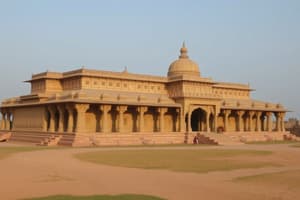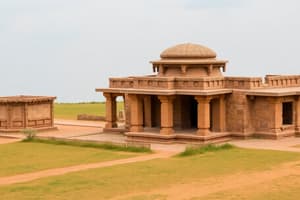Podcast
Questions and Answers
What is the main conflict described in the Mahabharata?
What is the main conflict described in the Mahabharata?
- The rivalry between the Kauravas and the Pandavas (correct)
- The struggle between gods and demons
- The relationships among the royal families of India
- The quest for knowledge by sages
Who is traditionally credited as the author of the Mahabharata?
Who is traditionally credited as the author of the Mahabharata?
- Vyasa (correct)
- Arjuna
- Krishna
- Valmiki
Which of the following best describes the Bhagavad Gita?
Which of the following best describes the Bhagavad Gita?
- A historical account of ancient India
- A narrative about the life of Rama
- A dialogue between Arjuna and Krishna (correct)
- A collection of hymns to various gods
What significant theme does the Ramayana reflect?
What significant theme does the Ramayana reflect?
In the Bhagavad Gita, what does Krishna say defines a sage?
In the Bhagavad Gita, what does Krishna say defines a sage?
What event leads to Rama's banishment in the Ramayana?
What event leads to Rama's banishment in the Ramayana?
What act does Sita perform in response to Ravana's advances?
What act does Sita perform in response to Ravana's advances?
How many couplets is the Mahabharata said to contain?
How many couplets is the Mahabharata said to contain?
What is the primary significance of the Vedic Period in relation to Aryan culture?
What is the primary significance of the Vedic Period in relation to Aryan culture?
Which of the following statements correctly describes the Rigveda?
Which of the following statements correctly describes the Rigveda?
What major literary works were composed during the Epic and Buddhist Age?
What major literary works were composed during the Epic and Buddhist Age?
Which empire is credited with promoting Buddhism during its rule?
Which empire is credited with promoting Buddhism during its rule?
What does the term 'nonviolence' primarily relate to during the Maurya Empire?
What does the term 'nonviolence' primarily relate to during the Maurya Empire?
During which period did Hinduism reach significant cultural and artistic development?
During which period did Hinduism reach significant cultural and artistic development?
What best describes the nature of hymns in the Rigveda?
What best describes the nature of hymns in the Rigveda?
What characterizes the chaos described in the Song of Creation?
What characterizes the chaos described in the Song of Creation?
Flashcards
Indus Valley Civilization
Indus Valley Civilization
An ancient civilization that flourished in northern India between 2500 and 1500 B.C.
Vedic Period
Vedic Period
A period in Indian history (1500 B.C.-500 B.C.) named after the Vedas, sacred hymns of Aryan culture.
Rigveda
Rigveda
The oldest Veda, a collection of hymns considered divinely inspired.
Epic and Buddhist Age
Epic and Buddhist Age
Signup and view all the flashcards
Mahabharata and Ramayana
Mahabharata and Ramayana
Signup and view all the flashcards
Aryans
Aryans
Signup and view all the flashcards
Maurya Empire
Maurya Empire
Signup and view all the flashcards
Gupta Dynasty
Gupta Dynasty
Signup and view all the flashcards
What is the Mahabharata?
What is the Mahabharata?
Signup and view all the flashcards
How many sections does the Mahabharata have?
How many sections does the Mahabharata have?
Signup and view all the flashcards
What is the Bhagavad Gita?
What is the Bhagavad Gita?
Signup and view all the flashcards
What's the central theme of the Bhagavad Gita?
What's the central theme of the Bhagavad Gita?
Signup and view all the flashcards
Who is Valmiki?
Who is Valmiki?
Signup and view all the flashcards
What is the Ramayana about?
What is the Ramayana about?
Signup and view all the flashcards
What are the major themes of the Ramayana?
What are the major themes of the Ramayana?
Signup and view all the flashcards
What does the Ramayana teach us about Sita's character?
What does the Ramayana teach us about Sita's character?
Signup and view all the flashcards
Study Notes
Indus Valley Civilization and Aryan Migrations
- Flourished in northern India between 2500 and 1500 BCE
- Aryans, nomadic warriors and herders, migrated to India. Brought a developed language, literature, and religious beliefs.
Vedic Period (1500 BCE – 500 BCE)
- Named for the Vedas, a collection of hymns.
- Hindus consider the Vedas as divinely revealed, orally transmitted by priests.
- Rigveda (1,028 hymns), the oldest Veda, contains strong, energetic hymns comparable to Old Testament psalms.
Epic and Buddhist Age (500 BCE – CE)
- Marked by the composition of the Mahabharata and Ramayana epics.
- Also saw the development of later Vedic literature, new Sanskrit literature, and Buddhist literature in Pali (e.g., Dhammapada).
- Maurya Empire (322-230 BCE) promoted Buddhism under Ashoka.
- Gupta Dynasty (320-467 CE) fostered the flourishing of Hinduism.
Mahabharata
- Traditionally attributed to sage Vyasa.
- An extensive epic detailing a struggle for supremacy between Kauravas and Pandavas (around 3102 BCE).
- Consists of 100,000 couplets in 18 sections (parvans).
- Explores dharma (codes of conduct) for various social roles (kings, warriors, etc.).
Bhagavad Gita
- A significant Hindu scripture, part of the Mahabharata.
- Dialogue between Prince Arjuna and Krishna (an earthly incarnation of Vishnu).
- Offers insights into duty and spiritual liberation.
Ramayana
- Composed in Sanskrit by Valmiki (likely not before 300 BCE).
- 24,000 couplets in seven books.
- Reflects Hindu values, social organization, karma, wifehood ideals, caste, honor, and promises.
- Story of King Rama, his exile, Sita's abduction by Ravana, the demon-king, Rama's victory, and later difficulties for Sita's purity.
Studying That Suits You
Use AI to generate personalized quizzes and flashcards to suit your learning preferences.




